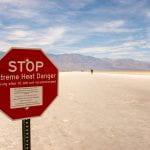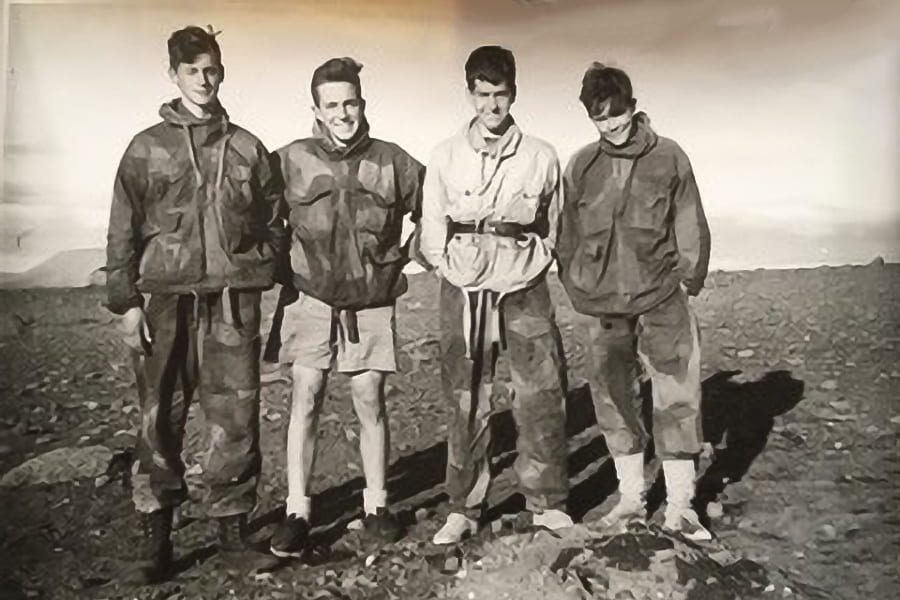Understanding the temperature limits of human safety
Older adults and others in extreme heat
Heatwaves can be fatal for large numbers of vulnerable people who do not have access to air conditioning. Individual factors—especially age, but also overall health, acclimation to heat, and medications being taken—set some people at greater risk than others from extreme heat.
“As people age, we know that they are more vulnerable,” said Tony Wolf, postdoctoral fellow in kinesiology and collaborator on this research. “We are documenting the limits of that vulnerability so that we can identify when to be concerned. If it is going to be 85 degrees tomorrow with 20 percent humidity, should we be concerned about older men and women’s exposure to the conditions?”
In hot environments, humans cool their bodies primarily by sweating. As people age, they sweat less efficiently, have lower levels of blood flow to the skin, and there is greater strain on their cardiovascular system. These factors put older adults at much greater risk from extreme heat than young, healthy people.
What puts people at risk from heat?
As people age, they do not sweat as much, they have lower blood flow to the skin, and there is a greater strain on their heart. These factors put older adults at greater risk during extreme heat events.

Temperature

Acclimation

Humidity

Health

Exertion

Medication
Author
Aaron
Wagner
Who is at elevated risk from extreme heat?
Click on each scenario to examine the risk.
30-year-old woman with no known health problems continues running outdoors during the heatwave.
Despite her good health, exposure to extreme heat during exertion is dangerous for anyone.
86-year-old woman who lives alone and is homebound in an air-conditioned apartment.
Despite her advanced age, air conditioning will moderate her risk if she uses her air conditioner, and the electricity does not fail.
Who is at elevated risk from extreme heat?
52-year-old man in good health who manages asthma with regular use of an inhaler.
There are specific classes of medication that increase risk, but asthma medication is not among them as long as his condition is managed.
76-year-old man who lives in a nursing home that does not have air-conditioning.
The combination of age and exposure to heat could be dangerous.
Climate change and geography
As climate change warms the planet, extreme heat events are becoming more common. The Oregon heatwave in June 2021 killed almost 100 people. Portland was hit particularly hard because people in the normally temperate city were unprepared for extreme heat. Similarly, a 2019 summer heatwave in France killed over 1,400 people, half of them over the age of 75. Due to climate change, communities and individuals need to be prepared for previously uncharacteristic extreme heat.
“The question of who is at risk is complicated,” said Daniel Vecellio, postdoctoral fellow at the Center for Healthy Aging and the climatologist on Kenney’s research team. “Our research has focused on people in Central Pennsylvania where our lab is located, but we know that heat acclimation is an important factor for understanding someone’s limits.”
To address potential regional differences in the environmental limits that people can tolerate, the researchers are collaborating with scientists in The Netherlands and Australia who will perform similar experiments. The collaboration will increase the overall sample size and reveal differences among people who live in different climates.
In this clip from PBS News Hour, Kenney discusses the dangers of extreme heat.
By June 2022, tens of millions of Americans had already endured temperatures over 100 degrees.
Addressing the most pressing needs at hand
Kenney came to Penn State as a graduate student in 1980, one year after the partial meltdown of the Three Mile Island nuclear reactor. Kenney’s graduate advisor connected him to work with the nuclear power industry on worker safety during the clean-up from the partial meltdown.
Workers at Three Mile Island were dressed in protective gear that Kenney compared to ‘three or four layers of Ziploc bags.’ The gear took two hours to put on, and then workers labored in an ambient temperature sometimes reaching 160 degrees Fahrenheit. After 20 minutes, workers were completely exhausted and done for the day.
“This experience sparked my interest in how humans regulate their temperature,” Kenney said. “And when I began to study temperature regulation, I was drawn to aging populations because older adults are far more likely to suffer or die during extended periods of extreme heat.”
What should people and governments do in the event of extreme heat?
Extreme heat events are becoming more common and are more likely to occur in areas where people are not prepared for them. Individual actions are critically important, but public policy also matters. Local officials should play an active role in alerting people of the potential danger of upcoming heat events, advising people how to care for themselves and others, and restricting dangerous activities.
Reduce outside time
People typically do this voluntarily during extreme heat, but some people will need restrictions.
Reduce physical exertion in non-air-conditioned places
This can be hard based on some people’s jobs, so employers and government officials need to be attentive to worker safety.
Facilitate access to air conditioning
People without A/C in the home, especially vulnerable populations, should be taken to a mall or other cool space to get relief during the hottest weather.
Maintain health now
The healthier someone is, the more resistant they are to extreme heat. Of course, good health has many benefits beyond heat tolerance.
Understanding human limits through practice, not theory
Since his work as a graduate student, Kenney has spent decades working to understand the impact of aging in extreme heat. While media and scientific establishments have embraced theoretical projections of critical environmental limits, Kenney has been one of the only scholars testing these limits in a laboratory setting.
There is variance in the ages and health of the participants and in the intensity of their activities, but the experimental protocol that the researchers follow remains largely consistent from one experiment to another. Prior to every experiment, participants swallow a tiny radio telemetry device encased in a capsule that measures their core temperature throughout the experiment.
Then, participants perform either light or moderate exercise, depending on the study. They enter a specialized environmental chamber that has adjustable temperature and humidity levels. While the participant performs light physical activity, like light cycling, or moderate activity, like walking on a treadmill, the chamber gradually increases in either temperature or humidity until the participant reaches a point at which their body can no longer maintain its core temperature, and it starts to rise.
The research team’s recent findings indicate that humans cannot tolerate as much heat as was previously believed. “Our results suggest that in humid parts of the world, we should start to get concerned—even about young, healthy people—at lower temperature and humidity combinations that previously projected,” Kenney said. “As we continue our research, we’re going to explore the temperature limits for people of all ages and levels of health.”
Limits for all people
The collaborations with other research groups will generate hundreds of observations about human limits. With these data, the research team believes they will be able to identify the critical environmental limits for people in a variety of health conditions and stages of life. As these limits are identified, policy makers will be able to determine how best to deploy resources during extreme heat events. In this way, many lives may be saved.
“Throughout my career, I have been working to help people understand what constitutes safe exposure to temperature in various conditions,” Kenney explained. “Now, we are looking at the biggest question I have ever addressed: what are the critical environmental limits for different people? As global warming increases the number of extreme heat events, this looms as a life-or-death question for thousands or even millions of people.”
The descriptions of the experimental protocols were adapted from a news story by Katie Bohn.
This research is funded by a grant from the National Institute on Aging.
Photo Credits
What puts people at risk from heat, icons by jattumongkhon via gettyimages.
Who is at elevated risk from extreme heat?:
- Image by Ivanko_Brnjakovic via gettyimages
- Image by digitalskillet via gettyimages
- Image by FG Trade via gettyimages
- Image by Dean Mitchell via gettyimages
What should People and goverments do?:
- Image by Momento Design via gettyimages
- Image by anttohoho via gettyimages
- Image by kornkun via gettyimages
- Image by Indigo Diamond via gettyimages
Footer Video – Image by Barks_japan via gettyimages
Author
Aaron Wagner








